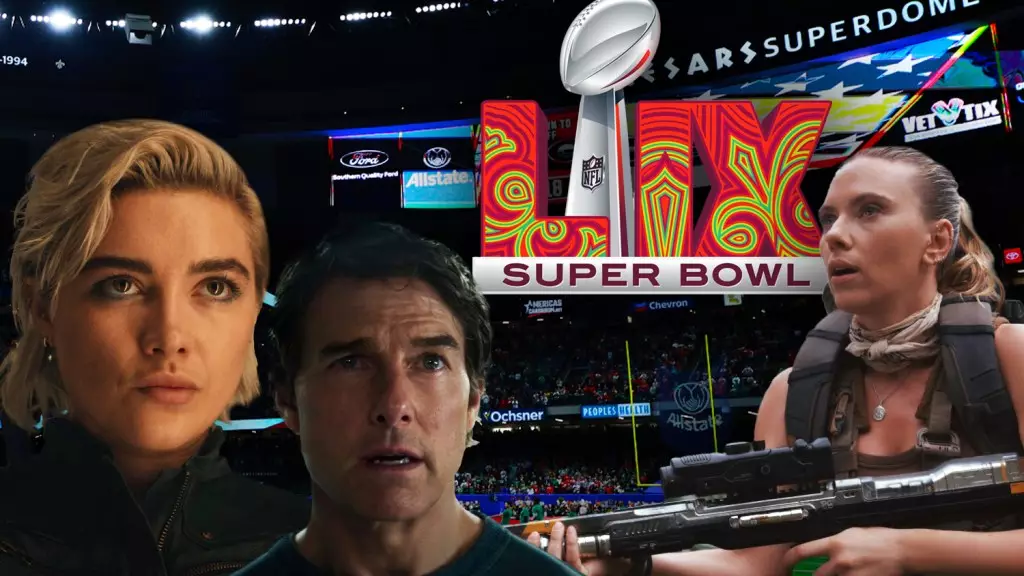The Super Bowl is not just a sporting event; it’s a major cultural phenomenon that brings together millions of viewers across the globe. With its staggering audience, the Super Bowl presents a unique opportunity for movie studios to capture the public’s attention and generate buzz for upcoming films. Each year, top studios prepare their lavish trailers and commercials in anticipation of this incredible platform. However, with costs for ad spots soaring into the millions, only a select few studios deem this investment worthwhile.
Securing a 30-second television advertisement during the Super Bowl isn’t for the faint of heart. As prices rocket to between $7.5 million and $8 million for just half a minute, studios must be incredibly strategic in their approach. In a landscape where just three heavyweights—Disney, Paramount, and Universal—are willing to pay such sums, the competition becomes fierce, and the stakes are high. Last year, Super Bowl LVI attracted a staggering 123.7 million viewers across various platforms, proving that despite discussions about the decline of traditional media, live sports continue to draw enormous audiences.
A Clash of Titans
This year, the Super Bowl LIX will feature a gripping rematch of the 2023 showdown between the Philadelphia Eagles and the Kansas City Chiefs, which clearly raises the profile of advertising during the event. With the Chiefs aiming for an unprecedented third consecutive title, the excitement surrounding the match is likely to pull even more viewers to their screens. This anticipation creates a fertile ground for studios looking to tease their next blockbusters, making sure they capitalize on the nationwide hype.
Studio Strategies in the Spotlight
Disney, fresh off an impressive domestic box office haul of over $2.2 billion last year, has a history of utilizing the Super Bowl to promote its major releases. This year, fans can expect teasers for films like “Snow White,” “Lilo & Stich,” and Pixar’s “Elio.” Moreover, Marvel Studios usually capitalizes on the occasion to unveil content related to its highly anticipated films, and this time will be no different, with titles like “Captain America: Brave New World” and “Thunderbolts” slated for teaser trailers. Disney has consistently leveraged the Super Bowl’s reach to create significant buzz before summer releases, enhancing its stronghold on box office revenues.
Conversely, Universal, which boasted $1.88 billion in domestic revenue last year, is set to thrill audiences with trailers for notable films such as the live-action adaptation of “How to Train Your Dragon” and the upcoming “Jurassic World Rebirth.” Universal has built a reputation for innovative advertising tactics, as seen during the first installment of the “M3GAN” franchise, which featured eye-catching promotional stunts that drove engagement.
Paramount is another experienced contender in this arena, although their participation varies from year to year. With plans to unveil trailers for “Novocaine,” a comedy thriller, and an animated musical featuring the Smurfs, Paramount seeks to make a significant impact. The studio has made its mark in previous Super Bowls, particularly with the “Mission: Impossible” franchise, emphasizing the longstanding relationship between exhilarating storylines and high-energy advertising campaigns.
While the spotlight shines brightly on these top three studios, others like Sony, Warner Bros., Netflix, and Apple Studios seem to be sitting this year out. This decision may reflect a shift in strategy or a reevaluation of expenditure toward such a costly advertising medium. The last time Warner Bros. made waves during the Super Bowl was with their marketing for “The Flash”, hinting that studios are increasingly selective about where they invest their advertising budgets.
As the event approaches, it’s clear that the Super Bowl continues to serve as a powerful catalyst for movie promotion. For studios, the opportunity to reach tens of millions of viewers is too significant to ignore, despite the hefty price tag. As we prepare for the highly anticipated match-up and the onslaught of trailers, one thing is certain: if you want to capture the attention of American audiences, aligning your film’s release with the Super Bowl advertising blitz might just be the golden ticket you need.

